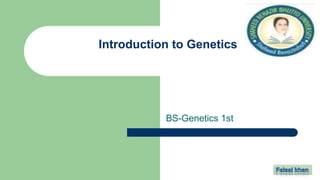
Introduction to genetics
- 1. BS-Genetics 1st Introduction to Genetics
- 2. The word genetics was derived from the Greek root gennō, γεννώ which means to give birth or to grow into It was coined by British biologist William Bateson in 1905/6 for the study of physiology of heredity and variations. Introduction
- 3. Definition Genetics is the branch of science/Biology Concerned with genes, heredity, and variation in living organisms (viruses, bacteria, plants and animals).
- 4. Genetics It seeks to understand the process of trait inheritance from parents to offspring, including Molecular structure and function of genes Gene behaviour in the context of a cell or organism, Gene distribution, and variation Change in populations.
- 5. Genes: Nucleotide sequence that stores the information which specifies the order of the monomers in a final functional polypeptide or RNA molecule. Genes, heredity, and variation
- 6. Heredity The process of transmission of characters from one generation to next, either by gametes – in sexual reproduction or by the asexual reproductive bodies in asexual reproduction, is called inheritance or heredity. Heredity is the cause of similarities between individuals. This is the reason that brothers and sisters with the same parents resemble each other and with their parents. Heredity and variation
- 7. Cont. Variation Any difference between cells, individual organisms, or groups of organisms of any species Is the cause of differences between individuals. This is the reason that brothers and sisters who do resemble each other are still unique individuals
- 8. Divisions of Genetics Traditionally, the study of genetics has been divided into three major sub disciplines: 1. Transmission genetics 2. Molecular genetics, and 3. Population genetics
- 9. DNA polymerase δ complex 1. Transmission genetics / classical genetics encompasses the basic principles of genetics and how traits are passed from one generation to the next This area addresses the relation between chromosomes and heredity, the arrangement of genes on chromosomes, and gene mapping.
- 10. Cont. Here the focus is on the individual organism — how an individual organism inherits its genetic makeup and how it passes its genes to the next generation.
- 11. 2. Molecular genetics concerns the chemical nature of the gene itself: how genetic information is encoded, replicated, and expressed It includes the cellular processes of replication, transcription, and translation — by which genetic information is transferred from one molecule to another — and gene regulation — the processes that control the expression of genetic information. The focus in molecular genetics is the gene — its structure, organization, and function.
- 12. 3. Population genetics explores the genetic composition of groups of individual members of the same species (populations) and how that composition changes over time and space. Because evolution is genetic change, population genetics is fundamentally the study of evolution. The focus of population genetics is the group of genes found in a population.
- 13. PCNA t is convenient and traditional to divide the study of genetics into these three groups, but we should recognize that the fields overlap and that each major subdivision can be further divided into a number of more specialized fields, such as chromosomal genetics, biochemical genetics, quantitative genetics, and so forth. Genetics can alternatively be subdivided by organism (fruit fly, corn, or bacterial genetics), and each of these organisms can be studied at the level of transmission, molecular, and population genetics.
- 14. DNA Polymerases Require a Primer to Initiate Replication Modern genetics is an extremely broad field, encompassing many interrelated sub disciplines and specializations. In recent years, the science of genetics has proliferated into numerous distinctive sub disciplines. Some of the significant branches of genetics are the following:
- 15. 1. Plant genetics. The genetics of plants. 2. Animal genetics. The genetics of animals. 3. Human genetics. It involves the study of heredity of human traits, human disorders, betterment and correction of human disorders. 4. Microbial genetics. It deals with the genetics of microorganisms (viz., viruses, bacteria, unicellular plants and animals).
- 16. 5. Fungal genetics or mycogenetics. The genetics of fungi. 6. Viral genetics. Genetics of virus. 7. Mendelian genetics. It involves study of heredity of both qualitative (monogenic) and quantitative (polygenic) traits and the influence of environment on their expressions. 8. Quantitative genetics. It involves the study of heredity of quantitative traits such as height, weight and IQ in human beings and milk production in cattle.
- 17. 9. Clinical genetics. Genetics involved in the detection of causes of diseases such as haemophilia, colour blindness, diabetes, phenylketonuria. 10. Immunogenetics. It deals with genetics of production of different types of antibodies; the diversity of antibodies has been found to be under control of genetic regulation.
